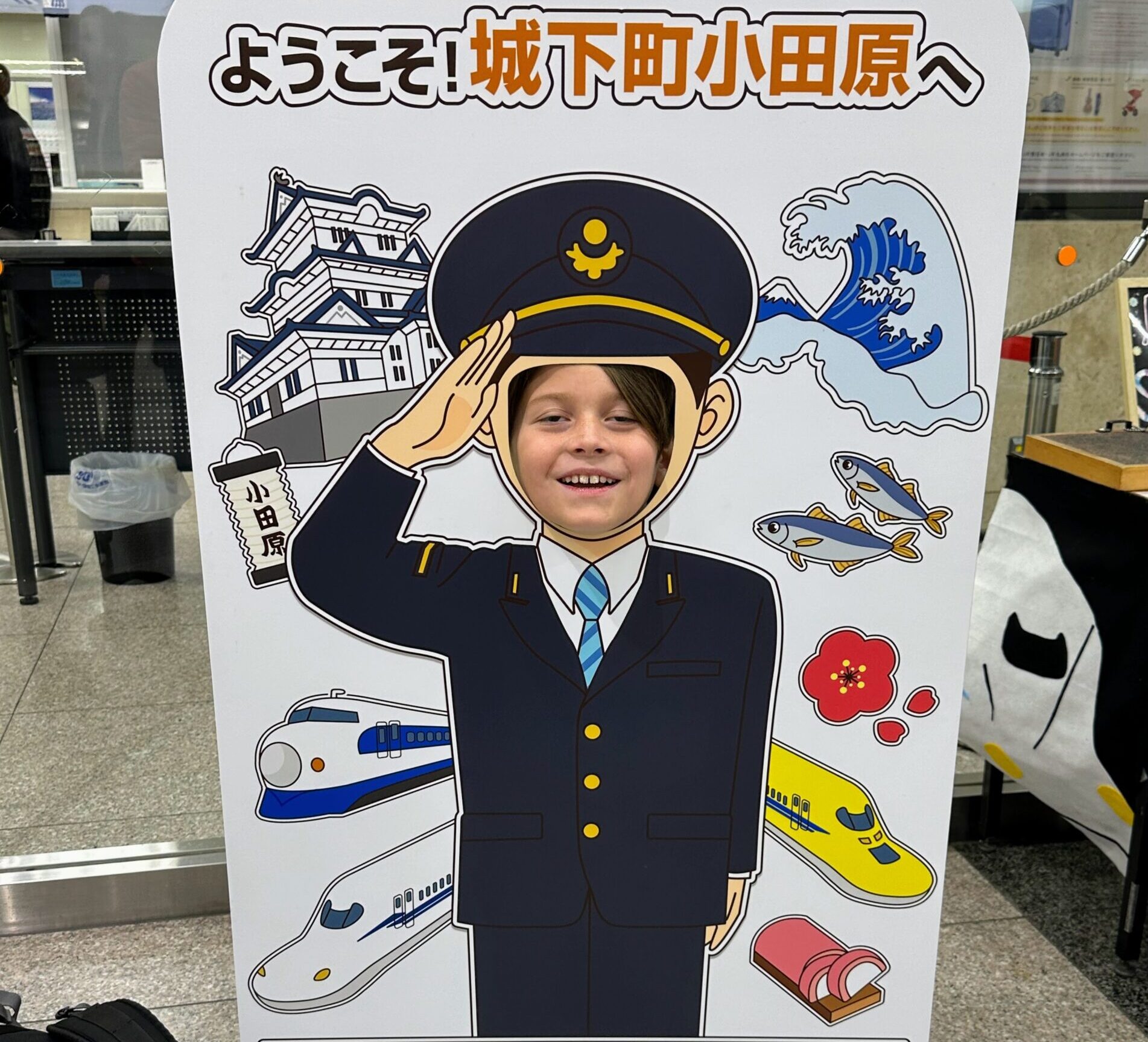— By Maggie Downs —
The melodic chime floated via Tokyo Station simply as our Shinkansen slid into view, silent and impossibly clean, prefer it was gliding on air. My 10-year-old son, Everest, stood frozen in awe, eyes tracing the smooth white bullet practice because it stretched far past both finish of the platform.
“It appears to be like like a spaceship,” he whispered.
I felt it too. Standing there with my husband, swept into the tide of brisk-footed commuters and vacationers with rolling suitcases, buzzing lights overhead with the scent of fried meals and brewed tea within the air. I stared at this gleaming marvel of engineering — and for a second, it did truly really feel like we had been about to launch into one other world.
Moments later, we had been hurtling via the Japanese countryside at practically 200 miles per hour, watching small cities and rice fields blur into watercolor smears whereas Everest demolished a Shinkansen-shaped sweet field from the snack cart. This wasn’t simply transportation; this was the stuff of childhood goals.
The Practice Turned the Journey
Earlier than our two-week household journey, which took us via Tokyo, Hakone, Kyoto, Nara, and Osaka, I’d learn sensible guides about visiting Japan. Then I rigorously mapped out temples, neighborhood sights, and udon outlets, assuming the practice would merely get us from one level to a different.
We dwell within the California desert, the place we don’t have a superb system of public transportation, so I knew the rail system in Japan — famously quick and environment friendly — could be a novelty for us. However the actual magic, I figured, would start as soon as we reached our locations.
I used to be flawed. The trains themselves shortly turned one of many journey’s greatest highlights. They weren’t only a strategy to journey, however a pleasure all their very own.
The Artwork of Easy Motion
At first look, Japan’s trains appeared like an intricate net of timetables, transfers, and unstated guidelines. Frankly, I used to be intimidated. I apprehensive we’d be fumbling via stations, second-guessing indicators, and lacking connections.
However as soon as on the bottom, all of it clicked. Google Maps guided us with stunning accuracy. Colour-coded indicators, English-language bulletins, and useful station workers stored us transferring with confidence.
After a couple of rides, we discovered our rhythm: Faucet the IC card (pay as you go sensible playing cards used for transportation and different funds), observe the arrows, board the fitting automobile, and settle in. No visitors, no looking for parking in a overseas metropolis. Simply time collectively, watching the world go by.
Tip: Purchase rechargeable IC playing cards on the airport or a significant station. Children underneath 6 journey free; older kids get discounted fares. In the event you’re doing in depth journey, a Japan Rail Move might be value it — use the fare calculator on the Japan Rail web site to see if the move will prevent cash.
The place the Practice Is the Playground
The stations alone deserved a while within the itinerary. Tokyo Station felt virtually like a theme park, boasting capsule toy machines, anime-themed snacks, unbelievable bento shows, memento outlets with enjoyable characters, and bakery counters so beautiful they appeared like artwork galleries.
Plus when a nationwide vacation shuttered most eating places in Kyoto, it was the station that saved us. We stumbled right into a conveyor-belt sushi spot nonetheless buzzing with life, turned dinner right into a sport, and watched Everest gentle up with each passing plate.
Tip: Don’t overlook practice stations as eating hubs. Many stations home total meals halls with choices from ramen to French pastries, and an incredible youngsters’ meal is commonly just some steps away.
The Low Factors (and What We Discovered)
In fact, not each journey in Japan was great. We discovered the arduous strategy to keep away from rush hour after a white-knuckle expertise being squeezed right into a packed practice automobile by Tokyo’s notorious “practice pushers” — uniformed workers who bodily shove individuals into already full vehicles. I felt like scorching canine meat being compelled into the casing.
Within the crush of individuals, I teetered on the sting of a panic assault. However this additionally confirmed us the exceptional civility of Japanese commuters, who made room for Everest and even helped information us off the practice at our cease.
After that, we prevented the 7 to 9 a.m. and 5 to 7 p.m. home windows and located the trains blissfully spacious throughout off hours.
One other problem: the sheer dimension of main stations like Shinjuku or Ueno. What Google Maps known as a “five-minute switch” typically meant speed-walking via subterranean corridors that appeared to multiply as we moved. On one exhausting night time in Shinjuku, Everest practically fell asleep strolling. Spirits had been low till we noticed a merchandising machine crammed with collectible practice toys. Our irritating detour immediately turned a treasure hunt.
Tip: Give your self buffer time for transfers in massive stations. They will take longer than anticipated, particularly with youngsters. And embrace the merchandising machines; they’re in all places and stuffed with surprises.
A Practice Designed for Pleasure
On day 5, we boarded the Romancecar from Shinjuku to Hakone. With its sweeping home windows and plush seating, it felt extra like a sightseeing lounge than public transit. Everest claimed the entrance seat like a junior conductor, narrating each tunnel and bridge we handed.
Even our shortest rides had been memorable. We squealed over themed trains, just like the Whats up Kitty Shinkansen, and stopped to admire each snack stand with regional specialties. Everest turned these snack breaks into tasting excursions. Curry buns, melon pan, chewy mochi, and different treats all turned a part of our journey story.
Tip: In case your youngster loves trains, contemplate visiting the Kyoto Railway Museum or the Railway Museum in Saitama close to Tokyo. And don’t miss the themed trains. Examine native rail strains for seasonal or character-branded rides.
Discovering Our Household Circulate
By the second week in Japan, we’d figured it out. We packed gentle with carry-ons solely, since Japanese trains aren’t made for large curler luggage. We discovered to ahead our baggage when wanted, so our suitcases awaited us on the subsequent resort, as if by magic. We adopted Everest’s lead with IC card tapping and snack scouting. He even developed a soundtrack, buzzing the melodic departure chimes from totally different stations.
We didn’t want screens or telephones. The motion, the home windows, the trains themselves had been the leisure.
Tip: Baggage forwarding service (known as takkyubin) is broadly obtainable at many resorts, airports, and comfort shops. It’s a lifesaver should you’re touring with giant luggage.
Leaving Japan: A Journey We Didn’t Wish to Finish
What stunned me most was how the trains slowed us down in the perfect means. We had area to speak, to take a seat quietly collectively, to marvel on the surroundings as an alternative of simply attempting to succeed in the following cease. Everest requested massive questions. My husband, who’s Japanese-American, shared tales from his personal childhood. As we explored Japan, we weren’t simply sightseeing; we had been seeing one another.
Even the smallest moments — a fellow passenger providing Everest a sweet, a station employee waving as we boarded — turned little sparks of connection.
On our closing journey to Kansai Worldwide Airport, Everest pressed his face to the window and whispered, “I’m going to overlook the trains.”
So was I. As a result of someplace between Tokyo and Osaka, we’d found what journey is basically about. Not simply the place you go, however the way you get there, and all of the little joys that come alongside for the journey.
—

Associated




